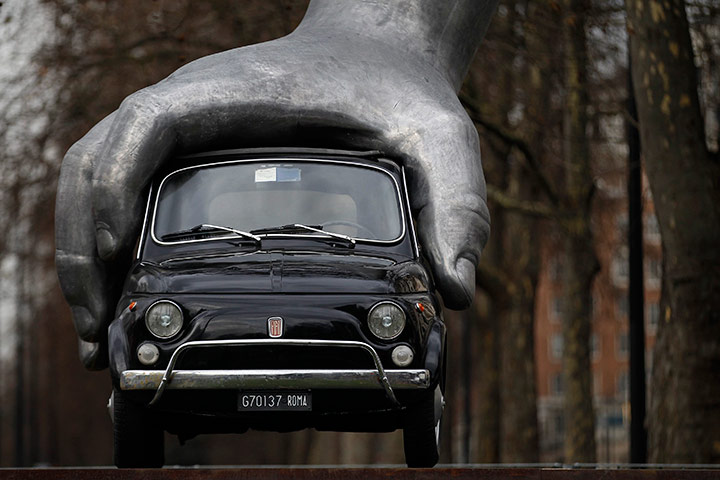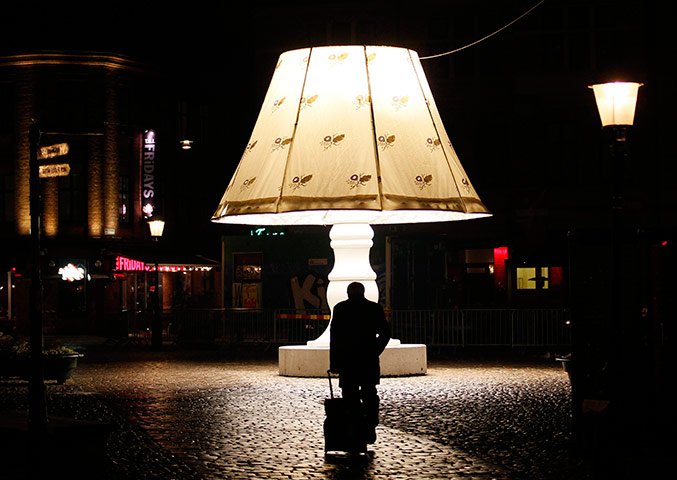Skyscrapers are big, and walking through the concrete canyons of a major city can make one feel small. But you can go to the observation decks high above the rest of the city, and everything looks small even though you know you are seeing miles upon miles of large buildings and great thoroughfares. You can walk through the busy streets and feel enlarged by the social energy coursing through the city, or you can lean while lost against an anonymous building and feel desolate, not much different from the scraps of paper blowing down the alley. If things go well, you might take a picture or send someone a postcard of the spectacular cityscape, but that, too, has been miniaturized by the technologies of visual reproduction. So it is that contemporary artists draw on distortions of scale to make one stop and think about where we are.
Lorenzo Quinn’s sculpture, “Vroom Vroom” is now on display in Park Lane in London. The Fiat 500 is held by an aluminum hand, as if the car were a child’s toy. The title of the work is not ironic, as the artist says that he wanted to recapture the innocence and excitement of childhood. By contrast with the stress of driving, parking, or dodging cars in crowded downtown streets, this artistic license seems a good way to go: Stop, smile, and think about how exciting simple things once were and can be, and about you already may have gotten your wish if you would but take the time to remember it.
That simple advice actually is harder to follow than it seems; one might say its about as easy as seeing a car as a toy car. As children, it was easy to see toy cars as cars, but now we need an artist (and considerable public investment) to recover such freedom of imagination. As well we should, and not as merely a break in a busy day, for good civic life requires just such inversions to be able to see problems, solutions, and possibilities. Public art, like the city itself, can school us in these shifts in scale so that we can become more likely to make sound judgments of magnitude, that is, of how much or how little needs to be done collectively for the general welfare.
And shifts in scale are not the only available inversions. When I looked at the photo above, which I saw without the title, I had a sense not of excitement but of something closer to foreboding. (No, I didn’t have a terrible childhood.) Sure, the idea of a child playing with a car is there, but the child is not so innocent in such moments, as the ability to play god is also involved. Perhaps I’ve seen too much science fiction or read too many Puritan sermons, but a hand coming out of the sky isn’t necessarily such a good thing. The artwork may suggest the role of chance in life, something more easily felt when aware of how small one is relative to the sheer numbers and size of city life. Cars are not plucked out of the air, but lives are crushed by being in the wrong place at the wrong time, and cities will not thrive if contingencies, including problems of scale, are not managed with imagination and vision.
And so one might even speak of light in the darkness.
But a table lamp? OK, a very big table lamp: this giant was placed in Lilla Torg square in Malmö, Sweden over the holidays. Not so much excitement here. As the man pulls his bag across the cobblestones of the otherwise deserted square, he seems a lonely figure, hunched a bit into his overcoat against the cold, left to his thoughts–so much so that he seems oblivious to the enormous artwork glowing in front of him. Yet the lamp highlights his isolation, for it has twice transformed the scene: first, by its inversion of scale, and second, by placing an artifact from the home in the public space. Instead of moving through a small square, he now appears dwarfed by the city, and instead of heading for home or hotel, he seems fated to be alone in any space, public or private. Perhaps the lamp was intended to brighten up the square with the light and decor of a gracious home, but it can just as well suggest that the city makes everyone homeless.
Inversions also can teach us that no one condition need be permanent. These artworks involve inversions of scale and of affect, and together they suggest both that big things can be made small and that small things can loom large. Questions of magnitude, otherwise known as the quality of life.
Photographs by Stefan Wermuth/Reuters and Yves Herman/Reuters.


Discussion